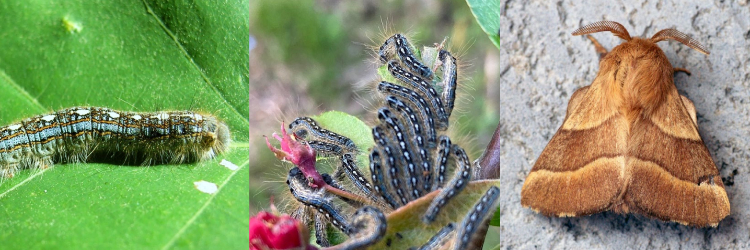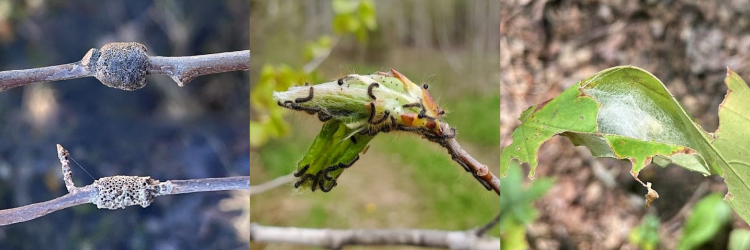DACF Home → Bureaus & Programs → Maine Forest Service → Forest Health & Monitoring → Forest Pest Index → Forest Tent Caterpillar
Forest Tent Caterpillar
Malacosoma disstria
Hosts
Primarily aspen (Populus spp.) in Maine, but also sugar maple (Acer saccharum), oak (Quercus spp.), birch (Betula spp.), and other deciduous hardwoods.
General Information
The forest tent caterpillar is a native defoliator of deciduous trees in Maine. Despite its name, this species does not construct webbed tents like the eastern tent caterpillar. Populations exhibit boom-and-bust cycles, with outbreaks typically occurring every 10–15 years and lasting about 2–5 years. At these times, wandering caterpillars become so abundant that road closures have been necessary due to unsafe driving conditions. The primary impact on the forest is of widespread defoliation, which can be quite dramatic in scale. Healthy trees can usually survive a couple years of heavy defoliation, though repeated stress may lead to mortality or increased susceptibility to secondary pests and diseases. Forest tent caterpillars are a natural and important food source for a variety of forest wildlife in Maine, and their outbreaks are usually kept in check due to native predators, parasites, and pathogens.

Life Cycle
Forest tent caterpillar overwinters as egg masses laid in bands around small twigs. These eggs hatch in late April to early May, with timing influenced by local weather and tree bud development. Larvae can be identified by the line of interrupted white keyhole markings down their back, with blue lines on either side. These caterpillars feed in groups over the following weeks before spinning silken cocoons and pupating. Emerging in early to mid-July, the adult moths are light brown with a wide, variable band spanning across the forewings, sometimes only visible by the two thin lines along the edges of the band. The adult form is short-lived, needing only to mate and lay eggs for the following season.
Symptoms and Signs
Affected trees show thinning crowns, with leaf damage ranging from some free-feeding up to fully consumed. During outbreak years, entire hillsides of aspen and other hardwoods may appear leafless by mid-June. In many cases, trees will refoliate a second flush of leaves later in the summer. Silken mats may also be visible and frass can accumulate on tree trunks, patios, decks, and vehicles. Caterpillars can be found on tree trunks, twigs and leaves, as well as roads, buildings, and other structures. Egg masses appear as brownish-gray cylindrical bands encircling twigs. Unhatched masses appear slightly shiny due to a protective covering, while hatched masses are lighter and duller in appearance.

Management
Hardwood trees can often tolerate multiple years of severe defoliation before showing long term health impacts, assuming other stresses, like drought, are not present. In ornamental settings, small infestations can be controlled manually by eliminating egg masses and caterpillars from twigs and the main stem. A shop vac with a couple of inches of water and a few drops of soap will also work to remove caterpillars from structures like porches. Cocoons on siding and other surfaces may be removed by a stiff-bristled broom.
If a tree has experienced complete defoliation for two consecutive seasons and a third is anticipated, insecticide treatment may be warranted. During outbreaks, systemic or foliar insecticides, including products containing Bacillus thuringiensis subsp. kurstaki (BtK), may be applied by licensed applicators following the label. BtK is not a contact insecticide and must be ingested by the caterpillars. It is most effective against early instar larvae. Treatment should be timed to occur after the hatch of all eggs and host leaf expansion sufficient to provide a surface for the treatment to adhere to. Weather conditions such as rain, unseasonably cool temperatures and wind may hamper treatment.
The number of egg masses laid in canopy branches during winter may predict future caterpillar population levels. Landowners may use an egg mass survey (protocol linked below) to inform management efforts.
Population control by natural enemies such as viral and fungal pathogens, predators, and parasitic flies usually brings outbreaks to an end without intervention. One notable species is Sarcophaga aldrichi, also known as the “friendly fly”. This native pupal parasite can reach very high numbers following a forest tent caterpillar outbreak.
Further Reading
Vermont Department of Forests, Parks & Recreation. Forest Tent Caterpillar Egg Mass Survey
Cooke, B.J.; Sturtevant, B.R.; Robert, L.-E. The Forest Tent Caterpillar in Minnesota: Detectability, Impact, and Cycling Dynamics. Forests 2022, 13, 601. https://doi.org/10.3390/f13040601
MAINE DEPARTMENT OF AGRICULTURE, CONSERVATION AND FORESTRY
Maine Forest Service - Forest Health and Monitoring Division
August 2025